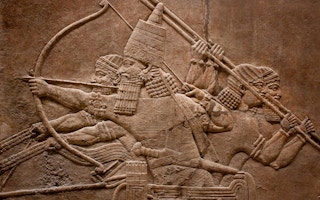Two scholars have a new explanation for the collapse of one of the great Bronze Age civilizations. The Assyrian empire of the 7th century BC – based in Nineveh, in what is now northern Iraq – may have collapsed at least in part because of a population explosion and climate change in the form of sustained drought.
And, they point out, there are lessons in ancient history for the modern world as well.
Adam Schneider, an anthropologist at the University of California, San Diego, and Selim Adali, of the Research Centre for Anatolian Civilizations at Koç University in Istanbul, Turkey, put forward their proposal in the journal Climatic Change.
They say that demographic and climatic factors played an indirect but significant role in the collapse of a civilization chronicled not just in clay tablets and archaeological marvels but in the Hebrew scriptures and the Christian Old Testament.
Historic links
The climate change theory of history is now well established. In the last two years, researchers have linked both the dissolution of the Minoan empire in the ancient Mediterranean and the collapse of Levantine civilizations of the near East and the Harappan civilization of the Indus Valley to sustained drought.
Others have identified seasons of plentiful rainfall as the impetus for the conquest of Russia, China and Persia by the Mongol horsemen of Genghis Khan.
The connections with modern conflict, too, have been made before. In 21 studies of upheaval and conflict in modern societies, researchers have found clear links with rises in temperatures.
And just days after the Assyrian study was published in Climatic Change, research in the Proceedings of the National Academy of Sciences identified a link between temperature and rainfall anomalies in sub-Saharan Africa and violence in the region during the last 30 years.
“
We, however, have no such excuses, and we also possess the additional benefit of hindsight, which allows us to piece together from the past what can go wrong if we choose not to enact policies that promote longer-term sustainability
Adam Schneider, anthropologist, University of California, San Diego, and Selim Adali, Research Centre for Anatolian Civilizations at Koç University, Istanbul
Schneider and Adali looked through what climate scientists call “proxy evidence” of rainfall patterns in the Tigris Valley of northern Iraq more than two and a half millennia ago.
They considered the evidence of lake sediments and confirmed that many parts of the region experienced a “short but widespread dry phase” during the mid-to-late 7th century BC.
They also unearthed written evidence from 666 BC that welcomed “copious rains, huge floods, a fine rate of exchange…” to mark a new accession to the throne. But by 657 BC, another letter stated that “this year’s rains were diminished and no harvest was reaped”.
In fact, Assyrian engineers had established an impressive series of canals, waterways, cisterns and reservoirs to conserve water, and archaeological finds reveal that the imperial farmers grew barley and wheat, grapes, cucumbers, pomegranates, flax and cotton among many other crops.
But demand, too, was on the increase. The empire of built by Sennacherib, a king identified in biblical chronicles, had ambitions for the local populations. In at least 20 known acts of mass deportation, half a million people were resettled in the heartland.
Nineveh grew fivefold in area, and the population growth, the scientists think, placed significant strains on the immediate supplies of food in the region.
Conflict and insurrection
Within five years of the 657 BC drought, the Assyrian economy was struggling, and conflict and insurrection had broken out. By 609 BC, a remarkable civilization had been destroyed.
A multi-year drought, the researchers argue, “would have placed serious stress on the agricultural economy of the Assyrian state and, by extension, upon the imperial political system”.
They see parallels with today, as the fate of the Assyrian empire offers lessons for modern society about the hazards of valuing short-term economic growth over long-term security and sustainability.
“The Assyrians can be ‘excused’ to some extent,” they conclude, “for focusing on short-term economic or political goals that increased their risk of being negatively impacted by climate change, given their technological capacity and their level of scientific understanding about how the natural world works.
“We, however, have no such excuses, and we also possess the additional benefit of hindsight, which allows us to piece together from the past what can go wrong if we choose not to enact policies that promote longer-term sustainability.”










